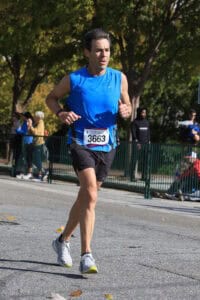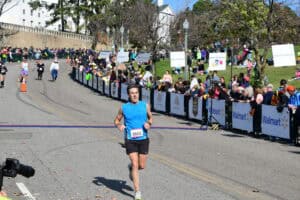Rob Waddell: 25 years of the Richmond Marathon, with the data to back it up
Rob Waddell, a long-time Richmond resident who recently relocated to Virginia Beach, will be running Richmond for the 25th consecutive time in this year’s Allianz Partners Richmond Marathon. A meticulous tracker of all pieces of running data, Rob has plenty of insight to share on running in general and Richmond in particular. This year’s race has extra meaning for Rob beyond just the 26.2 miles of running, as he’s also raising support and awareness for mental health through the National Alliance on Mental Illness. Rob took some time to share more about his experiences in a recent Q&A session, which you can read below.
Sports Backers: Let’s start with the Allianz Partners Richmond Marathon. This will be your 25th consecutive year of running here. What is it about Richmond and this race that you enjoy and appreciate so much?
Rob Waddell: We moved to Richmond in 1995 and I met a friend that turned me on to the marathon. I had been running 10k races and doing a lot of cycling, but there was something about the pursuit of long-distance races that I had always admired. In running my first Richmond Marathon in 1998, I was amazed by the local support for the race and the beauty of the race course in the fall season. I wanted to be a part of something that inspired the community in wellness pursuits and the benefits that it brings.
With each race, I came to realize these events are very special and not easy to organize and support. It’s hard to express the gratitude us runners have for organizations like Sport Backers and the army of community volunteers it takes to achieve such a great event. It takes planning, leadership, and dedication to vision to pull off what has been accomplished and my hat is off to all the volunteers in the community that have supported us all of these years.
SB: You’ve kept very detailed statistics and data on your performances over the years. How did that start, and what has it helped you learn in that time?
RW: When you train five months for each marathon and run two per year, you amass a lot of information that you realize correlates directly to your results. It all started in the pursuit of a Boston Marathon qualification, which I achieved on my second Richmond Marathon in 1999 (by 19 seconds). In that pursuit, I saw first-hand the successful results of paying attention to the details as supported by the data. This was long before the tracking apps we have today so I compiled a lot of spreadsheets on the details of my training. . I also tend to watch relative VO2 Max closely and my training plan ensures that peaks around race day. I cross train with total body, and specific leg and core exercises at least once per week.
I learned through this data that consistency in your training and following a gradual build-up of mileage is essential for making the start line healthy and ready to do your best. The data also shows you, over time, how things like age, diet, fitness, and other external factors (e.g., life stressors and weather) affect your results and so you make adjustments and stay realistic. I believe these adjustments and a consistent approach to training have allowed me to show up at the starting line for 25 years.
SB: This year’s race has extra meaning beyond just the 26.2 miles of running, as you’re raising support and awareness for mental health through the National Alliance on Mental Illness. Tell us more about that, and why it’s so important to you.
RW: Yes, this year’s race does have special meaning for me. It is best characterized by NAMI’s CEO, Dan Gillison, in this podcast: NAMI podcast – Episode 6 (buzzsprout.com). This podcast references a new book that NAMI recently help publish, “You are not Alone.” This important information shared by NAMI has helped me realize that the startling increase in homelessness, in many cases, is the result of individuals not getting the mental health intervention they needed before things spiraled out of control.
The pandemic only accelerated this for many who were borderline cases. Now with a national crisis on our hands, I believe it’s time to remove the stigma which has so long surrounded mental health. We need to educate through organizations like NAMI so those affected by mental health issues have a chance to reclaim and build back their lives. You can donate to this cause on my fundraising page here: https://donate.nami.org/fundraiser/3752445
SB: Do you have any specific goals for this year’s race, in terms of fundraising and/or finishing time?
RW: Over the years, I’ve learned not to get too fixed on an expected finish time. Every marathon brings its own set of variables we cannot control, especially weather. With that said, I trained to pace at my average finish time of the 24 Richmond marathons, which is 3:27, and I will aim to beat that time. Beyond that, I want to run free of expectations and finish #25 on the goodwill spirit of a community that is so supportive.
As far as fundraising goes, I have been able to raise over $6,000 so far and the ultimate goal is now $10,000.
SB: Lastly, do you have a particular favorite memory from the Richmond Marathon, or a favorite part of the course, from your time running here?
RW: My fondest memories will always be my family and friends cheering me on at the end of a good race, and their help and kindness on the tough ones. There is no better feeling than coming into the finish of the marathon!
As far as the race course, I absolutely love the beautiful tree-lined streets in full fall colors. The party zone near mile seven, as well as the section of the course near Pony Pasture, are both very special areas. Many of the spectators that cheer us on at those spots probably don’t realize we actually recognize them from year to year, and we love their support! Lastly, you know it is going to be a good day when the persistent headwind on the Lee Bridge is favorable!
Rob Waddell’s Top Tips for the Allianz Partners Richmond Marathon
- At the start, don’t get caught up with the fast starters. The best way to do this is to keep the pace you trained for in mind right out of the gate. Nor should you focus on other runners’ pacing or running styles through the rest of the race. Focus on you!
- Race-day adrenaline will want to kick in, but hold back and run conservatively through mile 10. The reason is there is a long downhill between mile 6 and 7, and then a steady incline just before mile 10 that will test your resolve.
- I find it is best to get some water and electrolytes at every water station I can, as this, along with your fueling early, can make a difference late in the race.
- My goal is always to get through the Forest Hill area around mile 14 with some reserves in the tank. This gives you confidence and some strength to weather the Lee Bridge headwind and get through mile 16 keeping your mind free and clear of any negativity. Keep the right pace and stay upbeat!
- Miles 16 to 18 are where I want to keep focus on pacing up W. Main Street, which is slightly uphill for over a mile. If you do this conservatively and stay steady, you will round mile 18 onto Arthur Ashe Boulevard and feel great that you now have conquered the tougher part of the course. If it is a sunny day, take advantage of the shade provided by the buildings by running on the left side of W. Main Street.
- Now you’re on a mission to get through mile 20 with some energy to push through the last 10k. If you have run within yourself, fueled properly, and let the race come to you, then you will stay close to your planned pace through to the finish. And, oh what a great feeling that is!
I had to learn these things the hard way over 25 years, but if you keep these things in mind, you won’t have to!
###

